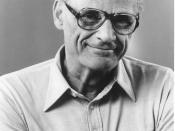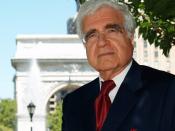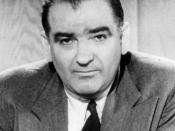Witchcraft has always been of interest to me, quite simply because for five years I lived in Sabden; a village that sits at the bottom of Pendle Hill in Lancashire. Pendle had had its fair share of witches and I was keen to know more about Salem?s. It wasn?t until after I read the play that I could understand the true horror of innocents being accused and killed. Research showed that at the time the people were living in fear of almost everything. The settlers in New England had to cope with Indian tribes, unknown lands, and had to build a new community.
Salem never had any form of entertainment. They read no books except the Bible, they never celebrated Christmas, and a holiday meant that they would concentrate more on their prayers. Salem was strongly religious and the society feared the outside world which lay beyond their small community.
They believed that the dark wilderness was the last place God had reached. Here, the Devil worked his dark powers and would sometimes attack the village. They feared the unknown. They feared things that they could not explain. They lived in a world where they minded other people?s business, creating paranoia and no doubt, when the hysteria began, acted as a catalyst.
Everything that could not be accounted for was assumed to be the cause of witchcraft. And when one little girl?s illness couldn?t be explained, a wild and deadly finger began to sweep across Salem. People who had old scores to be settled, (usually over land), could take their revenge in what they thought was a justified way. The innocents became the accused, the accused were forced to confess to things they never did and then told to accuse other innocents. ?It is imaginative terror . . . the closed and suffocating world of the fanatic, against which the intellect and will are powerless.? (Richard Hayes) Even people such as John Proctor, who stood up and tried to make Salem see sense, was pulled down into the madness. ?[He was] so patently the enemy of hysteria that his very existence [was] a challenge to the fanatic temperament, and he [was] consumed by its malice.? (Richard Hayes) Although Arthur Miller changed the facts for his play, one thing is certain; it is a parallel to the events that took place in 1950s America. During in the 1940s-50s, America was coming obsessed by the fear of communism. Their government wanted to stop the communism spreading out of Russia and into other countries. They feared that communists were secretly trying to destroy the ?American way of life? and introduce communism into the country. As with Salem, the fear grew and Senator Joe McCarthy began to lead the anti-communist ?witch-hunt? movement.
The events strike a startling resemblance to the 1692 trails. Again, people were being put on trial and had to answer questions about their personal lives, friends, work and their political beliefs. They were even asked to name other people. If they refused to answer, or it was decided that they were communists, they were black-listed and no longer could get jobs. If they knew someone who was a communist, they too were labelled as one. All together, there were over 3 million names handed over. Like Salem, were a whole community was put in fear, the nation of America was too at fear. (Between May 1953 and October 1954, 6926 people working in government civil service jobs were fired because they were thought to be a ?security risk?).
Arthur Miller himself was put on trial and he knew that if he said any other names, they too would be put forward. He was asked about several meetings to which he attended where there were Communist Party writers. They wanted to know who was there in the room with him. Miller replied: ". . . I am not protecting the Communists or the Communist Party. I am trying to . . . protect my sense of myself. I could not use the name of another person and bring trouble on him . . . I take the responsibility for everything I have ever done, but I cannot take the responsibility for another human being." Once I knew all about this, the play took on a whole new meaning for me. Not only was it based on true events that Miller describes as ?the essential nature of one of the strangest and most awful chapters in human history?, but also it reflected similar events in our recent past. The Crucible suddenly became a much deeper play when I read it again, and after I put the play down, a sense of sadness and anger swept over me.
I believe in our performance we managed to reflect the hysteria of 1692. Whether the audience released it was written with the McCarthy era in mind, I don?t know, but we did tell one horrific story of America?s past. The only thing I can think of is that the McCarthyism of the 1950s hasn?t really any meaning to people today. Unless they lived in the 50s, they wouldn?t fully understand what happened. To be honest, although I read about the McCarthyism and understood its relevance within The Crucible, I soon forgot about it. I couldn?t see how the events of 1950s America would act in anyway to stop us from performing The Crucible.
If there were any problems with the play, they would have been small. One thing that I noticed at first was the language that Miller uses. Even though he elaborated some of the grammatical forms, (inparticular, double negatives), the language stuck close to that of the time. When I was reading it aloud at first, I was stumbling all over the place. Sentences weren?t making any sense. But I finally became use to it fairly quickly. (Maybe because I enjoyed the way they spoke). It was easy to follow and I found it easier to improvise with the language more than I could when I was performing with the language of the Restoration period. (The Country Wife). Eventually, it flowed almost naturally and at times during the performance were my lines were almost coming out backwards, due to nerves, I still managed to keep going and make sense using the language. I know that some others in the group had changed their lines so that they could remember them, but from the start I tried to keep to what Arthur Miller had written.
I found that the costumes helped a great deal for helping me to get into character and into the period. Once I placed it on, I noticed that I was moving differently to what I had been doing during other rehearsals. And when we moved onto the set and I saw the others in costume, it helped a great deal. I was pleased that the set was minimalistic - it would have felt too cluttered if there were a lot more props lying around. Also, I felt that I had more space to move around in - I didn?t feel confined, like sometimes you do when there?s so much on the stage and there are a lot of characters around you.
Although today?s audience won?t relate The Crucible to events that happened in the 1950?s, (unless they have knowledge of that time), they would surely understand what happened in the Salem Witch-Trails of 1692. I have often asked myself could we ever relate both events to anything happening today? I think we can. Just recently, there?s been problems with teachers and pupils. Parents have been falsely accusing the children?s teachers of ?touching? them and this has lead to innocent members of staff loosing their jobs when they didn?t do anything they considered wrong. Teachers now no longer have a ?hands on session? with the pupils, but more of a ?hands off? session.
There were also allegations against the singer Michael Jackson, as many parents put their children forward saying that he had said things or touched them in sexual ways. When one started, they all started. (Personally, I think the parents were doing it for the money). The same would apply to Bill Clinton. When Monica Lowinsky spoke out, so did many other women who claimed they had slept with the president.
The Crucible tells a horrific story and I feel that we told it well. I hope audiences can learn from what we showed them and that they are weary of it happening again.





